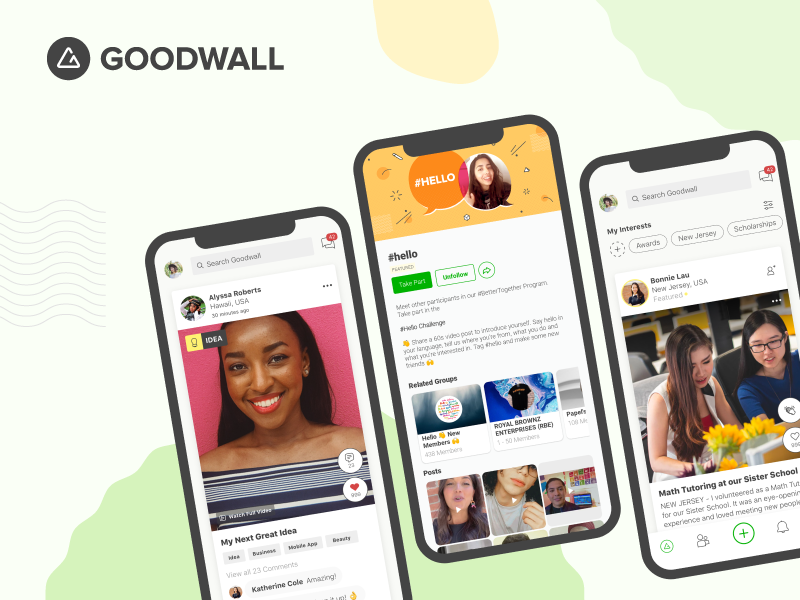Most of us have a LinkedIn profile, but many people don’t optimize their profiles or even know about all the features available to them.
If you’re searching for a job, this could certainly set you back.
In this post, we’ll give you some of our best LinkedIn tips, from how to make your profile complete to strategies for optimizing your account to beat out other job seekers to your dream interview.
Ready to get started?
Scroll down below to learn our best LinkedIn profile tips!

Looking to Land Your Dream Job?
Sign up to Goodwall!
- Learn skills to become more competitive
- Create a professional portfolio to highlight accomplishments
- Search through over 5 million jobs & internships
- Ask career questions and receive support
Download the app now to get started for FREE!
Here are some of the best LinkedIn profile tips and advice we can offer:
1. Complete Your LinkedIn Profile
When a hiring manager or recruiter searches your name on Google, your LinkedIn profile should be one of the first things to appear.
That’s a good thing … unless it turns them off.
And, nothing turns off hiring managers and industry recruiters faster than seeing an incomplete profile.
Writing resumes and cover letters are important, of course, but a LinkedIn profile is meant to show employers the entire picture of your professional life. While you need to choose the most relevant accomplishments, skills, and other entries when writing a cover letter or resume, LinkedIn gives you the room to list everything (within reason). In the following LinkedIn profile tips, we’ll go into detail on some of the important sections to optimize.
2. Give Them a Compelling About Section
Think of this as a brief introduction as to who you are professionally. Like a resume summary or objective paragraph, include what you think is most relevant to a recruiter at a company with a job you’re trying to land. For anyone viewing your profile on LinkedIn, this is their first impression of you and should make them want to scroll down deeper to learn more about you.
Related Read: 10 Important Skills Employers Look For & Will Want In 2022 & Beyond
3. Showcase Your Best Work in the Featured Section
Depending on your line of work, the Featured section on LinkedIn may either be irrelevant or super helpful. This section allows you to wow your target audience by displaying links to posts, articles, media, and other digital items, perfect for graphic designers, writers, web developers, etc. However, it can also be great to highlight a proud achievement in any industry, like if there’s a newspaper article about you winning a coveted award as a volunteer, for example.
4. Go Deep Into Your Work Experience
This LinkedIn section really needs no introduction, as it is almost identical to its resume counterpart. One benefit of LinkedIn’s version is that you can write several lengthy paragraphs here; hiring managers viewing it will see a collapsed version which they can easily expand to see its entirety. As in the job history section on your resume, include each job title, company name, key accomplishments, and dates worked. LinkedIn will automatically sort your work experience to put your current job title first and the rest under in reverse-chronological order (and they’ll also add the company’s logo, if available).
Related Read: 10+ Best High-Paying Jobs Without a Degree Required (w/ Salary Info!)
5. Write a Great LinkedIn Education Section
Similar to the academic area on a resume, the education section doesn’t need much explanation. On LinkedIn’s version, which follows the work experience section, you’re given the space to show off your school or university, the degree or diploma earned, field of study, years, grades, activities, societies, and any extra description you’d like to include.
6. Highlight Industry Licenses and Certifications
Depending on your professional goals, the LinkedIn section for including a license or certification may be super handy. Whether you want to include your certification as a cybersecurity analyst or a license to teach elementary education in your home state, make your profile stand out with all the relevant information.
Related Read: 15+ Best Jobs of the Future: What Jobs Will the World Need In the Future?
7. Proudly Proclaim Any Volunteer Experience
As we advise in our resume writing tips, any volunteer work you’ve done should go in its own volunteer experience section. The great thing about LinkedIn’s version is that it lets you select the cause (animal welfare, poverty alleviation, civil rights, etc.) your work benefited.
8. Include Your Top Abilities in a Professional Skills Section
The skills section on LinkedIn is a bit different than what you’ll have on a resume’s skills section, as companies often look for matches to their job descriptions here when searching for suitable candidates. On LinkedIn’s skills section, you can include up to 50 of your professional abilities and talents.
Then, to prove you are actually as skilled as you claim, there are two unique options. For some skills, say SEO, machine learning, or Adobe Illustrator, you can take a 15-question skill assessment. If you score in the top 30%, you’ll earn a skill badge (a blue checkmark on a clipboard) to help build trust.
The second feature for proving your skills is to earn endorsements from other LinkedIn users. Any of your connections should be able to endorse one or many of your skills, which will add a number next to the skills in question to help prove to hiring managers how talented you are.
Related Read: Travel Jobs: 11 Incredible Jobs That Allow You to Travel Around the World
9. Write a Relevant, Attention-Grabbing Headline
We’ve now gone pretty deep into all the LinkedIn profile section tips (although there are still many more to include). But, let’s go back up to the top of your profile for a second to talk about one of the most important parts of a great LinkedIn profile: the headline.
On LinkedIn, the headline is a place just below your name where you get to describe yourself in a few words. Many people use their current job title or most recent one, but you should actually use whatever you think is the best few words about who you are as a professional. While you can describe yourself as a “Marketing Specialist,” for example, it may be more insightful and appealing to call yourself a “Social Media Marketing Ninja” or list your top specialties like “SEO, SEM, PPC.”
10. Go Further Than Your Resume
Your resume should be no more than 2 pages in length at most, and really no more than 1 page for young professionals and students. However, you can, and should, go much deeper on your LinkedIn profile page.
If you have a job irrelevant to your career goals, you can still add it. For example, a first-time job as a fast food worker doesn’t need to go on a resume for software engineering jobs, but it won’t hurt on a LinkedIn profile page. Actually, it probably helps, as most recruiters and hiring managers expect use LinkedIn to understand your entire professional history.
Related Read: Employee Perks and Benefits: What Are They & What’s the Difference?
11. Use a Professional Headshot
You may love your profile picture to be a meme or a blurry picture or something obscene on your other social media profiles, but keep it professional on LinkedIn.
Choose something that clearly shows just your head and shoulders, if possible, on a white or light-colored background. If you have the time and can afford spending a few bucks, go to somewhere where they take passport photos so you can get a professional headshot. Smile, where something nice, and you can even update any other professional portfolio or personal website you have with the same image.
12. Spend Money on LinkedIn Premium
Since I just talked about spending some money, I’ll try to convince you to spend a bit more. Signing up for LinkedIn premium (around $30/month in the United States) gives you one heck of an advantage when searching for jobs.
While it may be hard to afford for university students or those watching their budget closely while job hunting, it could definitely help decrease the amount of time you pound the pavement. With Premium, you can see all the jobs where you’re a top applicant based on your profile data and skills, and you can see if any hiring managers or recruiters view your profile. On top of all that, you get 5 InMails (an email-like feature to send messages to people even when they’re not a connection), access to LinkedIn Learning, and the ability to use their resume builder.
Well, that’s all our LinkedIn profile tips and advice for now, and we hope it helps you optimize your own profile to perfection. If you have any questions, feedback, or other great tips for LinkedIn profiles, let us know in the comment area below, and thank you for reading!
Related Read: Work-Life Balance: What It Is & Strategies for How to Manage It Effectively



